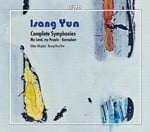3(I=picc).3.3.3-4.3.3.1-timp(2).perc(3)-strings
Abbreviations (PDF)
Bote & Bock
Yun's Exemplum in memoriam Kwangju [Example, in memory of Kwangju] relates to the popular insurrection in the South Korean provincial capital of Kwangju in May 1980. Between the assassination of dictator Park Chung-hee in October 1979 and the official proclamation of the new dictatorship of Chun Doo-hwan in March 1981, there was a phase of open, brutal military repression. The military established martial law – thus creating circumstances completely deprived of rights – soon after Park's death, first for most of the country, then, in May 17th, 1980, for the whole of South Korea. On May 18th, 50,000 students protested in the city of Kwangju, but the demonstration was violently quelled by special-force paratroops. Scenes of extreme brutality triggered off a popular uprising in which the greater part of the city's population of 800,000 participated. Due to the unexpected vigour of the revolt, the military retreated to the suburbs of Kwangju and later offered negotiations. But they were just playing for time. After a long siege, they stormed the city on May 27th, slaying about 3,000 people. 500 more were imprisoned, tortured and arbitrarily sentenced to jail.
By commission of the West German broadcasting station WDR, Exemplum was composed at the beginning of 1981. The first of the work's three parts opens with the gathering of the demonstrating and successively describes insurrection and massacre. The slow centre part reflects the people's paralysing horror and their mourning for the dead. The third part, however, with its appeal to continue the struggle for justice and democracy in South Korea, displays visionary features.
The first section consists of mainly two phases. Brightened up by xylophone and glockenspiel, several tutti-beats on G - for the composer a symbol of young people's vigour and decis1veness – signal the start of the rebellion. They lead to gun-shot-like double-triplets in the brass section (measure 6). While the wood-winds react with a hurried motion, the strings at first rest in consternation, then join, together with the bassoons and horns, the righteous march of the demonstrators at Kwangju. This is interrupted by trombones, tuba and timpani. A first attempt of re-formation is frustrated by a massive intervention of the brass instruments. A second attempt seems to be more successful, as on one side strings and wood-winds reach a state of apparent solidarity, and on the other side the brass instruments change from an opposing role to a supporting one (m. 36/37).
In the second phase the initial theme returns in a variation (m.47). The tone G reappears, now widened into a sound-belt, in the upper octave – for Yun the expression of an advanced stage, This time, the signal leads to a stylized battle scene: the up and onwards-movement of the strings is followed by the retreat of the wood-winds.
A gradual but determined rising of the strings – a move towards liberation – is again interrupted by the brass.
A second battle-scene follows, at first suggested through sound-gestures, later completed in a realistic manner. Here the conflicts are intensified: The wood-winds pick up the upwards-movement of the strings until fragments of the march-intonation face gun-shot-like double-triplets of the brass. The multiple-beat-whip pak simulates shell-bursts.
The slow middle section with its gradually increasing conception reflects the sinister calm after the massacre. A period of apparent paralysis is followed by awakening which culminates in the appeal of brass and timpani. A Lamentoso by strings and wood-winds – mourning and accusation, then an iridescent sound web with imbedded horn-calls conclude the slow part.
Call-signals from the trumpets, a symbol of resurrection and emergence, open the third part. The marching of the righteous starts anew. In spite of the interference of the brass instruments, this time, it cannot be held up.
Walter-Wolfgang Sparrer (translation: Wolfgang Vieweg)

State Symphony Orchestra of the Democratic Peoples Republic of Korea / Byung-Hwa Kim
CPO 999 165-2
